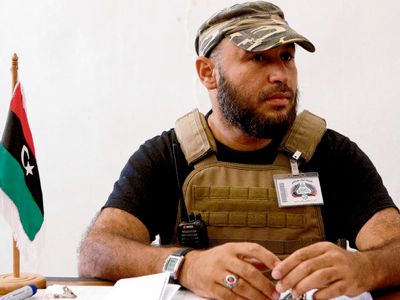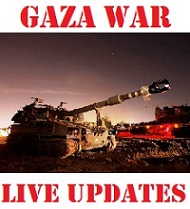*
Martin Iqbal Empire Strikes Black 3 febbario 2012
Il 31 maggio 2010, terroristi israeliani commisero un atroce atto di violenza che ebbe ripercusioni in tutto il mondo. Una cosa sorprendente per chi non ha familiarità con la storia di terrorismo, odio, sangue e omicidio d’Israele. Altri invece, come i palestinesi, che si ritrovano in intima familiarità con il modus operandi dell’entità sionista usurpatrice, non potevano che guardare senza sorpresa questo macabro ricordo di ciò che ‘Israele’ rappresenta.
Dopo il fatto, sono emerse delle informazioni potenzialmente esplosive, delle implicazioni che meritano una riflessione più attenta. Ci sono indicazioni che il massacro della flottiglia di Gaza dell’aprile 2010, sarebbe ben lungi dalla violenza di routine di Israele, ma una piuttosto una ben pianificata operazione, effettuata con la piena collaborazione del governo turco. Gli obiettivi dell’operazione erano molteplici, ma si pensa che l’assassinio a sangue freddo di quelle nove persone, in acque internazionali, fosse parte integrante della guerra attuale contro la Siria.
Il 17 dicmbre 2011, l’articolo del giornalista spagnolo Daniel Iriarte rivelava un certo numero di fatti importanti. (1) Mentre era in Siria, Iriarte aveva parlato con tre libici collegati ad Abdelhakim Belhaj (preziosa risorsa della NATO e macellaio di Tripoli). Illustrando quanto fosse strumentale per l’intelligence occidentale, Belhaj venne collegato ai falsi attentati di Madrid da nientr’altri che l’ex primo ministro spagnolo Jose Maria Aznar.
Inoltre, è stato un indispensabile pedone della ragnatela della NATO, facendo da spola tra la Libia e la Siria (2), al servizio del nefasto legame occidentale-GCC-israeliano che ora lacera entrambe le nazioni. Quando Iriarte incontrò questi libici, che a quanto pare non fecero alcun tentativo di nascondere la loro identità o nazionalità, affermarono di essere in Siria per “valutare i bisogni dei fratelli rivoluzionari siriani“. Uno degli uomini era il libico-irlandese Mahdi al-Harati, comandante della Brigata di Tripoli e il vice di Abdelhakim Belhaj, a capo del Consiglio militare di Tripoli.
Il Consiglio Militare di Tripoli è una forza mercenaria della NATO, incaricata di unificare i mercenari che combattevano la guerra terrestre della NATO in Libia; in sostanza di eseguire il lavoro sporco degli occupanti.
In una comunicazione molto rivelatrice, al-Harati disse ad Iriarte che venne “ferito nell’assalto alla Mavi Marmara, e che trascorse nove giorni in carcere a Tel Aviv“.
NSNBC ha recentemente pubblicato un pezzo molto importante dal titolo “GLADIO, da Bin Laden a Erdogan, Belhadj e Hamas: Mossad e la biancheria sporca della NATO nel 2012“(3).
Christof Lehmann – redattore di NSNBC – ha rivelato a questo autore che una sua ben informata fonte palestinese gli ha confidato che, oltre ad al-Harati, il tesoruccio della NATO Abdelhakim Belhaj era anch’esgli a bordo della Mavi Marmara, quella fatidica notte.
I lettori non dovrebbero essere sorpresi dal fatto che Mahdi al-Harati, che viveva senza preoccupazioni in Irlanda, con centinaia di migliaia di sterline della CIA, (1) fosse stato rilasciato senza problemi dalle autorità israeliane, dopo l’attacco alla flottiglia.
Dopo tutto, al-Harati è stato diligentemente al servizio dell’agenda israelo-occidentale, tornando in Libia dall’Irlanda all’inizio della controrivoluzione di febbraio (come l’agente della CIA Khalifa Haftar) (4), al fine di comandare ‘le forze ribelli’ della NATO.
I lettori dovrebbero invece chiedersi che cosa stessero facendo questi due agenti dell’intelligence occidentale a bordo della Mavi Marmara – una nave per gli aiuti che stava navigando verso Gaza, afffittata dalla coscienza e dal buon cuore degli attivisti umanitari di tutto il mondo, in solidarietà alla Palestina.
Si pensa che il massacro della flottiglia di Gaza sia stato un grande inganno orchestrato da Turchia e Israele, al fine di facilitare l’eliminazione di alcuni personaggi turchi che si sarebbero opposti alla guerra di Erdogan contro la Siria. Persuadere questi uomini, essendo membri dei Fratelli Musulmani e di altri gruppi affiliati, ad entrare nella flottiglia non sarebbe stato un compito difficile, anche considerando che probabilmente si opponevano con veemenza a Israele, ma tenendo presente la loro opposizione alle intromissioni in Siria.
La presenza altamente probabile degli agenti della NATO Belhaj e al-Harati sulla nave (per facilitare l’assassinio degli obiettivi degli squadroni della morte dell’IDF), conferisce credibilità a questa teoria, così sul modo in cui sono stati uccisi i cittadini turchi: esecuzioni sommarie a bruciapelo.
La relazione della missione dell’Ufficio dell’Alto Commissario delle Nazioni Unite per i Diritti Umani (OHCHR) sull’attacco israeliano alla flottiglia di Gaza, pubblicato nel settembre 2010, provò definitivamente (5) che sei delle vittime erano state uccise in ‘stile esecuzione’ dai terroristi israeliani.
La relazione ha rilevato che non solo Furkan Dogan venne sommariamente giustiziato, come gli altri obiettivi di questa violenza israeliana, ma venne immobilizato a terra per ‘qualche tempo’, incapace di reagire, prima che gli si sparasse in testa a bruciapelo. Questo metodo di esecuzione, usato dagli agenti israeliani, suggerisce che avevano l’ordine di uccidere metodicamente certi passeggeri della nave.
Questa idea è fortemente corroborata dalle notizie secondo cui i soldati dell’IDF avevano già le liste dei bersagli da assassinare (6), quando presero la nave. Un altro obiettivo strategico di questa operazione era mobilitare il sostegno pubblico turco a favore di Erdogan, che immediatamente adottò un atteggiamento aggressivo (ma completamente vuoto) nei confronti d’Israele. Questo sostegno pubblico era destinato ad essere incanalato in una campagna turca contro la Siria – una campagna in cui gli agenti della NATO Belhaj e al-Harati erano e sono intimamente coinvolti.
Christof Lehmann ha descritto il massacro della flottiglia per Gaza come “la falsa bandiera più ingannevole nella storia contemporanea“. Nel momento in cui Hamas – la fazione principale della resistenza palestinese all’usurpazione israeliana – ha cominciato ad allinearsi con il Qatar e l’Arabia Saudita (7) (che sono tra gli architetti della guerra in Libia e Siria), questa possibilità sembra chiara, convincente e degna di attenta considerazione.
Aggiornamento del 4 febbraio 2012
Un articolo del 3 giugno 2010 di Ali Abunimah è molto importante al riguardo. Nel suo articolo intitolato “Israele tenta di assassinare lo sceicco Raed Salah, sulla Mavi Marmara, ma uccide invece un ingegnere turco“, (8) Abunimah presenta alcune prove circostanziali che supportano l’idea che l’assalto israeliano alla flottiglia sia stata un’operazione di omicidio mirato. Ricordiamo – Israele non aveva alcuna reale necessità di assalire la nave sparando con tutte le armi – la sua marina era semplicemente in grado di danneggiare le eliche e di rimorchiare la nave in porto.
Le informazioni presentate da Abunimah suggeriscono che Israele abbia tentato di assassinare il palestinese cittadino d’Israele e influente figura del Movimento islamico, lo sceicco Raed Salah. Il cittadino turco Ibrahim Bilgen vene assassinato dai soldati israeliani, che piantorono quattro pallottole su di lui – alla tempia, al petto, ai fianchi e alla schiena. Abunimah teorizza che Bilgen sia stato scambiato per Salah dagli squadroni della morte israeliani, a causa della sua estrema somiglianza fisica. Questo è evidente quando si giustappongono le immagini dei due uomini (8).
Inoltre, l’articolo di Abunimah fa riferimento a un video della presunta ‘lista della morte’ trovata sulla flottiglia. Il seguente passo dell’articolo di Abunimah sottolinea ulteriormente l’idea che i soldati dell’IDF fossero lì col preciso scopo di uccidere certe persone:
Nelle preghiere del Venerdì, secondo al-Jazeera, Al-Haj Sheikh aveva detto che i soldati israeliani selezionarono dei passeggeri per l’esecuzione – quasi come se scegliessero quali animali uccidere.
Chi erano le persone nominate nella presunta ‘lista della morte’? Erano le stesse persone che Israele avrebbe poi assassinato? Tenendo presente l’assassinio probabilmente per errore di Ibrahim Bilgen, e la morte del 19.enne Furkan Dogan (un ragazzino che non avrebbe potuto essere un bersaglio di tali profonde dispute geopolitiche), c’è un’alta probabilità che i morti non siano stati tutti obiettivi prefissati da Israele.
Poichè Israele ha avuto ed ha il monopolio completo di video, foto e tutte le prove fisiche che furono lasciate sulla nave (probabilmente ora tutte distrutte), ci siamo in gran parte limitati a speculazioni.
Turchia e Israele post-Flotilla: il mito dei legami recisi
A un anno dal massacro della flottiglia, i legami economici e militari tra la Turchia e l’entità sionista erano in pieno boom, mettendo da parte il mito che le due nazioni avessero tagliato (o anche leggermente ridotto) i loro contatti.
Due articoli, uno del quotidiano Hurriyet della Turchia e uno del New York Times, danno un quadro convincente della stretta integrazione economica e militare di cui Israele e Turchia continuano a godere, nonostante la finta postura di Erdogan.
Menashe Carmon, un uomo d’affari israeliano che è nato a Istanbul, ha detto al New York Times (9) che poche settimane dopo il massacro della flottiglia, “Non c’erano compagnie israeliane che stessero lasciando la Turchia“, e che “Il business è business, e null’altro, e che gli investimenti sono crescita.”
L’articolo del NYT sosteneva, inoltre, che secondo funzionari turchi una stretta cooperazione tra Israele e l’esercito turco continuava dietro le quinte, anche dopo lo spargimento di sangue della flottiglia:
Poche settimane dopo il raid alla flottiglia, una delegazione militare turca era arrivata in Israele, per apprendere come utilizzare lo stesso velivolo senza pilota utilizzato da Israele per dare la caccia ai militanti palestinesi nella Striscia di Gaza. L’affare dei droni da 190 milioni dollari non era stato cancellato, anche se gli istruttori israeliani in Turchia furono richiamati dopo il raid.
Doron Abrahami, membro dello staff presso il Consolato israeliano a Istanbul, aveva anche rivelato che una importante collaborazione nella ricerca e sviluppo, tra Israele e Turchia, era stata commissionata solo poche settimane dopo l’assalto alla Mavi Marmara. Questa era solo una delle 20 analoghe iniziative di collaborazione:
“Gli affari sono affari“, ha detto, mostrando un invito del 15 luglio, co-firmato dalle agenzie economiche di Turchia e Israele, poche settimane dopo il raid israeliano, che invitava le aziende israeliane e turche a presentare offerte per una ricerca cofinanziata e sviluppata, una delle oltre 20 operazioni del genere che si diceva fossero in corso.
L’Export Manager della società turca Necat Yuksel (che ha importato 40 milioni di dollari di prodotti chimici da Israele, nel 2009), ha rivelato che le vendite da Israele non hanno mostrato segni di rallentamento. In realtà, non un solo contratto era stato annullato. (9)
Circa un anno dopo, un dirigente della turca Yakupoglu aveva parlato con Hurriyet, nel maggio 2011. Il manager aveva rivelato (10) che la Turchia acquistava equipaggiamenti bellici high-tech da Israele, mentre l’esercito d’Israele veste prodotti turchi, soprattutto gli stivali dell’esercito. Inoltre, parlando un anno dopo l’attacco alla flottiglia, il manager rivelava che non vi era stata alcuna interruzione negli affari della sua azienda con Israele.
Il commercio tra Israele e la Turchia ha raggiunto il picco di 3,442 miliardi di dollari, alla fine del 2010 (l’anno del massacro della flottiglia), rispetto ai 2,580 miliardi nel 2009 (10).
Uriel Lynn, presidente della Camera Centrale di Commercio israeliana e di Tel Aviv, ha detto a Hürriyet che “i rapporti commerciali Turchia e Israele sono sempre più forti, nonostante i conflitti politici … i turchi e gli israeliani non sono in lotta; il boom del commercio in entrambi i paesi dimostra che … il commercio e gli investimenti bilaterali non sono stati affatto colpiti dalla situazione politica.”
Nel secondo trimestre del 2011, la Turchia era il principale partner commerciale d’Israele nella regione, e il secondo nel mondo, secondo Ahmet Reyiz Yilmaz – a capo del Gruppo Yilmazlar – da 17 anni coinvolto nei grandi progetti edilizi in Israele.
Insieme, tutte queste relazioni di poco dopo l’attacco flottiglia, e di circa un anno dopo, dimostrano chiaramente che non c’era assolutamente alcuna sospensione degli strettissimi legami economici e militari tra Israele e Turchia. Qualsiasi degrado percepito nelle relazioni era solo retorica, il massacro della flottiglia di Gaza non ha avuto alcun effetto significativo sul partenariato tra l’entità sionista e la Turchia.
Note
(1) ‘Islamistas Libios se desplazan a Siria para ayudar a la revolucion‘ – ABC.es
(2) ‘Free Syrian Army commanded by Military Governor of Tripoli’, Thierry Meyssan
(3) ‘GLADIO, Bin Laden to Erdogan, Belhadj and Hamas: Mossad´s and NATO´s Dirty Underwear 2012′, di Christof Lehmann (3)
(4) ‘A CIA commander for the Libyan rebels’ di Patrick Martin
(5) ‘UN Fact-Finding Mission Says Israelis “Executed” US Citizen Furkan Dogan’ , Gareth Porter
(6) ‘Turkish Sources – Israeli Advance Target Assassination List Found on Flotilla’ – Redacted News
(7) ‘Hamas and al-Jamaa al-Islamiya: The New MB Look’ – Al-Akhbar English
(8) ‘Did Israel try to assassinate Sheikh Raed Salah on Mavi Marmara but kill a Turkish engineer instead?’, Ali Abunimah
(9) ‘Turkey and Israel Do a Brisk Business’, Dan Bilefsky
(10) ‘Business as usual between Turkey, Israel’ – Hürriyet Daily News, 30 Maggio 2011
*
Traduzione di Alessandro Lattanzio – SitoAurora
Link originale: Was the Gaza Flotilla Massacre a Turkish-Israeli False Flag and Precursor to the War on Syria? – Empirestrikesblack.com
Reloaded by TerraSantaLibera.org at http://wp.me/pVY5r-Le
*
Was the Gaza Flotilla Massacre a Turkish-Israeli False Flag and Precursor to the War on Syria?
Updated Saturday 4 February, 2012. Click here to go to the update.
On 31st May 2010, armed Israeli terrorists committed a heinous act of violence that sent shockwaves around the world. It stunned those not familiar with Israel’s history of terrorism, hatred, bloodshed and murder. Others however, including the Palestinians who are intimately familiar with the usurping Zionist entity’s modus operandi, could only look on unsurprised at this macabre reminder of what ‘Israel’ represents.
After the fact, potentially explosive information has surfaced – the implications of which warrant close consideration. There are indications that the Gaza flotilla massacre of April 2010 could have been far from a routine act of violence on the part of Israel, but instead a long-planned operation carried out with the full cooperation of the Turkish government. The aims of the operation were manyfold, but it is thought that the cold-blooded murder of those nine people in international waters was part and parcel of the ongoing war on Syria.
A December 17, 2011 report by Spanish journalist Daniel Iriarte reveals a number of key facts.(1) While in Syria, Iriarte spoke to three Libyans connected to Abdelhakim Belhaj (precious NATO asset and butcher of Tripoli). Illustrating how instrumental he has been to Western intelligence, Belhaj has been linked to the Madrid false flag bombings by none other than ex Spanish Prime Minister Jose Maria Aznar. Furthermore, he has been an indispensable footsoldier of the NATO nexus, shuttling from Libya to Syria(2) in servitude of the nefarious Western-GCC-Israeli nexus now tearing away at both nations. When meeting with Iriarte these Libyans, who apparently made no attempts to conceal their identity or nationality, claimed to be in Syria to “assess the needs of the Syrian revolutionary brothers“. One of the men was Libyan-Irish citizen Mahdi al-Harati – commander of the Tripoli Brigade and second in command to Abdelhakim Belhaj, who is leader of the Tripoli Military Council. The Tripoli Military Council is a proxy force of NATO, tasked with the job of unifying the mercenaries fighting NATO’s ground war in Libya, essentially performing the occupiers’ dirty work.
In a very revealing disclosure, al-Harati tells Iriarte that he was “wounded in the assault on the Mavi Marmara, and spent nine days in jail in Tel Aviv“.
NSNBC recently posted a very important piece titled “GLADIO, Bin Laden to Erdogan, Belhadj and Hamas: Mossad´s and NATO´s Dirty Underwear 2012“.(3)
Christof Lehmann – editor of NSNBC – revealed to this writer that a well-connected Palestinian source of his informed him with confidence that in addition to al-Harati, NATO darling Abdelhakim Belhaj himself was also on board the Mavi Marmara on that fateful night.
Readers should not be surprised that Mahdi al-Harati, who has been living care-free in Ireland with hundreds of thousands of pounds of CIA cash,(1) was released scot-free by the Israeli authorities after the flotilla attack.
After all, al-Harati has been dutifully serving the Western-Israeli agenda, returning to Libya from Ireland at the outset of the counterrevolution in February (just like CIA asset Khalifa Haftar),(4) in order to command the NATO-aligned ‘rebel’ forces.
Readers should instead be asking what these two Western intelligence assets were doing aboard the Mavi Marmara – an aid ship that was sailing to Gaza, commissioned by the conscience of good-hearted humanitarian and Palestine solidarity activists from around the world.
It is thought that the Gaza flotilla massacre was a huge deception orchestrated by Turkey and Israel in order to facilitate the elimination of certain Turkish figures who had been opposed to Erdogan’s intended war on Syria. These men, thought to be members of the Muslim Brotherhood and other affiliated groups, would have been coaxed into joining the flotilla – not a difficult task considering that they would likely be vehemently opposed to Israel, keeping in mind their opposition to meddling in Syria.
The highly probable presence of NATO assets Belhaj and al-Harati on the ship (to facilitate the murder of the targets by IDF death squads) lends credence to this theory, as does the nature in which the murdered Turkish citizens were killed: summary executions at point blank range.
The report of the fact-finding mission of the Office of the United Nations High Commissioner for Human Rights (OHCHR) on the Israeli attack on the Gaza flotilla released in September 2010 found conclusively(5) that six of the victims were murdered ‘execution style’ by the Israeli terrorists.
The report found that not only was Furkan Dogan summarily executed like the other targets of this Israeli violence, but he had been laid on the ground for ‘some time‘, incapacitated, before he was shot in the head at point blank range. This method of execution used by the Israeli operatives suggests that they were under orders to methodically kill certain passengers of the ship.
This idea is strongly corroborated by reports that IDF soldiers were carrying advance target assassination lists(6) when they boarded the ship.
Another key strategic aim of this operation was to rally Turkish public support for Erdogan, who immediately took a (completely hollow) aggressive stance towards Israel. This public support, it was intended, was to be channelled into a Turkish campaign against Syria – a campaign in which NATO assets Belhaj and al-Harati were and are intimately involved.
Christof Lehmann described the Gaza flotilla massacre as the “most deceptive false flag in contemporary history“. At a time when Hamas – the main faction of Palestinian resistance to Israeli usurpation – is beginning to align itself with Qatar and Saudi Arabia(7) (who are counted amongst the architects of the wars on Libya & Syria), this possibility seems distinct, compelling, and worthy of close consideration.
Update: Saturday 4 February, 2012
A June 3, 2010 report by Ali Abunimah is highly relevant to this issue. In his article titled, “Did Israel try to assassinate Sheikh Raed Salah on Mavi Marmara but kill a Turkish engineer instead?“,(8) Abunimah presents some circumstantial evidence that supports the idea that Israel’s boarding of the flotilla was an exercise in targeted murder. Let’s remember – Israel had no real need to board the ship with all guns blazing – its capable navy could have simply disabled the propellers and towed the ship into port.
The information put forward by Abunimah suggests that Israel attempted to assassinate Palestinian citizen of Israel and influential Islamic Movement figure, Sheikh Raed Salah. Turkish citizen Ibrahim Bilgen was murdered by Israeli soldiers who put four bullets into him – in the temple, chest, hip and back. Abunimah theorises that Bilgen was mistaken for Salah by the Israeli death squads due to his extremely close physical likeness. This is apparent when one juxtaposes the images of the two men.(8)
Further, Abunimah’s report references a video of the alleged ‘death list’ found on the flotilla:
The following passage from Abunimah’s report further underscores the notion that the IDF soldiers were there for the express purpose of murdering specific people:
In Friday prayers, according to Aljazeera, Al-Haj Sheikh said that the Israeli soldiers selected which passengers to execute — almost like choosing which livestock to kill.
Who were the persons named on the alleged ‘death list’? Were they the same people who Israel successfully murdered? Keeping in mind the likely mistaken killing of Ibrahim Bilgen, and the death of 19 year old Furkan Dogan (a mere child who could scarcely have been a target of such deep geopolitical wrangling), there is a high likelihood that those killed were not all Israel’s intended targets.
Since Israel had and has a complete monopoly of the video footage, photo evidence, and all physical evidence that left the ship (most probably all now destroyed), we are largely limited to speculation.
Turkey and Israel post-Flotilla: the Myth of Severed Ties
A year on from the flotilla massacre, economic and military links between Turkey and the Zionist entity were booming, putting paid to the myth that the two nations had severed (or even slightly reduced) their ties.
Two reports – one from Turkey’s Hürriyet Daily News and one from the New York Times – paint a compelling picture of the close military and economic integration that Israel and Turkey have continued to enjoy despite hollow posturing on the part of Erdogan.
Menashe Carmon, an Israeli businessman who was raised in Istanbul told the New York Times(9) mere weeks after the flotilla massacre that “No Israeli companies are leaving Turkey,” and that, “It is business as usual and if anything, investment is growing.”
The NYT report also claims that, according to Turkish officials, close cooperation between Israel the Turkish military was continuing behind the scenes in the wake of the flotilla bloodshed:
Within weeks of the flotilla raid, a Turkish military delegation arrived in Israel to learn how to operate the same pilotless aircraft often used by Israel to hunt Palestinian militants in the Gaza Strip. The $190 million deal for the drones was not canceled, even as the Israeli instructors in Turkey were called home after the raid.
Doron Abrahami, staffer at the Israeli Consulate in Istanbul even revealed that an important research and development collaboration between Israel and Turkey was being commissioned only weeks after the assault on the Mavi Marmara. This was only one of 20 similar collaborative efforts:
“Business is business,” he said, showing off an invitation dated July 15, co-signed by economic agencies in Turkey and Israel just weeks after the Israeli raid, inviting Israeli and Turkish companies to bid for a jointly financed research and development project, one of more than 20 such efforts he said were under way.
The Export Manager at Turkish company Necat Yuksel (that imported $40 million worth of plastic chemicals from Israel in 2009), revealed that sales from Israel showed no signs of slowing. In fact, not a single contract had been cancelled.(9)
Approximately a year later an executive from Turkey’s Yakupoğlu spoke to Istanbul’s Hürriyet Daily News in May 2011. The executive revealed(10) that Turkey buys high-tech defence hardware from Israel, while Israel’s army is dressed by Turkish products – mainly army boots. Crucially, speaking one year after the flotilla attack, the executive revealed that there had been absolutely no interruption in his company’s business with Israel.
Trade between Israel and Turkey peaked at $3.442 billion at the end of 2010 (the year of the flotilla massacre), up from $2.580 billion in 2009.(10)
Uriel Lynn, president of the Tel Aviv & Central Israeli Chamber of Commerce told Hürriyet, “Turkey and Israel’s business relations are getting stronger despite the political conflicts…Turks and Israelis are not in a fight – the trade boom in both countries proves that…bilateral trade and investments have not been affected by the political situation at all.”
By the second quarter of 2011, Turkey was Israel’s biggest trade partner in the region and its second-biggest in the world, according to Ahmet Reyiz Yılmaz – the head of Yılmazlar Group – which has been involved in large construction projects in Israel for 17 years.
Together, these reports from shortly after the flotilla attack and approximately a year later, clearly demonstrate that there was absolutely no let-up in the intimately close military and economic ties between Israel and Turkey. Any perceived degradation in relations was rhetorical only; the Gaza flotilla massacre had no significant effect on the partnership between the Zionist entity and Turkey.
Notes
(1) ‘Islamistas Libios se desplazan a Siria para ayudar a la revolucion’ – ABC.es
(2) ‘Free Syrian Army commanded by Military Governor of Tripoli’ by Thierry Meyssan
(3) ‘GLADIO, Bin Laden to Erdogan, Belhadj and Hamas: Mossad´s and NATO´s Dirty Underwear 2012′ by Christof Lehmann
(4) ‘A CIA commander for the Libyan rebels’ by Patrick Martin
(5) ‘UN Fact-Finding Mission Says Israelis “Executed” US Citizen Furkan Dogan’ by Gareth Porter
(6) ‘Turkish Sources – Israeli Advance Target Assassination List Found on Flotilla’ – Redacted News
(7) ‘Hamas and al-Jamaa al-Islamiya: The New MB Look’ – Al-Akhbar English
(8) ‘Did Israel try to assassinate Sheikh Raed Salah on Mavi Marmara but kill a Turkish engineer instead?’ by Ali Abunimah
(9) ‘Turkey and Israel Do a Brisk Business’ by Dan Bilefsky
(10) ‘Business as usual between Turkey, Israel’ – Hürriyet Daily News, 30 May, 2011
*





















